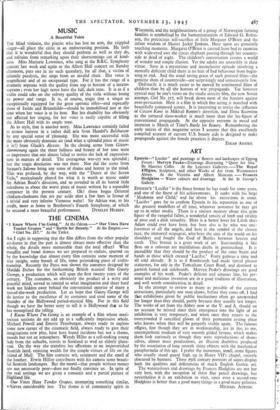THE CINEMA
4. I Know Where I'm Going." At the Odeon. " Our Vines Have Tender Grapes " and " Battle for Beauty." At the Empire. " Girl No. 217." At the Tatter.
Am I right in supposing that the film differs from the other popular art-fornis in that the part is almost always more effective than the whole, the details more memorable than the total effect? What maudlin and banal themes we are prepared to endure, spurred on by the knowledge that almost every film contains some moment of true insight, some breath of life, some painstaking piece of crafts- manship. Recently the Press was shown the costumes designed by Matilda Etches for the forthcoming British musical film Gaiety George, a production which will span the first twenty years of the century. The costumes, so obviously the product of a witty and graceful mind, served to remind us what imagination and sheer hard work arc hidden away behind the conventional exterior of many a run-of-the-week production. Let us hope that Gaiety George will do justice to the excellence of its costumes and steal some of the thunder of the Hollywood period-musical film. For in this field though we have the better story to tell it is Hollywood that so far has monoplised the telling.
I Know Where I'm Going is an example of a film whose meri- torious sections do not add up to a sufficiently impressive whole. Michael Powell and Emeric Pressburger, always ready to explore some new corner of the cinematic field, always ready to give their imaginations new play, have here found incidents but not a theme, moods but not an atmosphere. Wendy Fliller as a self-seeking young lady from the suburbs, travels to Scotland to wed an elderly pluto- crat. On the way she transfers her affections to an impoverished Scottish laird, rejecting wealth for the simple virtues of life on the island of Mull. The film contains wit, sentiment and the smell of the heather. Erwin Hillier contributes with his camera some beauti- ful Scottish landsoapes. But the morel—that people without money are not necessarily poor—does not finally convince us. In spite of the real settings we are given a romantic and a partial picture of Highland life.
Our Vines Have Tender Grapes, attempting something Similar, achieves considerably less. The theme is of community spirit in
Wisconsin, and the neighbourliness of a group of Norwegian farming families is symbolised by the humanitarianism of Edward G. Robin- son, the precocious -self-sacrifice of little Margaret O'Brien and the infant wisdom of Master Jackie Jenkins. Here again are genuinely touching moments. Margaret O'Brien is carried from bed to examine with wide-eyed awe the circus elephant passing through her country- side at dead of night. The children's conversation creates a world of wonder and simple illusion. Yet the adults are unearthly in their virtue. Save in a mysterious and inconclusive episode involving a mentally deficient. child there is no hint of bad behaviour from begin- ning to end. And the usual saving grace of such pastoral films—the genuine shots of countryside—are surprisingly and unnecessarily few. Ordinarily it is much easier to be moved by sentimental films of children than by all the horrors of war propaganda. Yot however cynical may be one's views on the studio atrocity film, the new Soviet attempt, Girl No. 257, will break down most of the barriers against over-persuasion. Here is a film in which fine acting is matched with beautifully composed scenes. It is interesting to notice the influence of Citizen Kane in Mikhail Romm's direction, and Elena Kuzmine as the tortured slave-worker is much more than the lay-figure of conventional propaganda. At the opposite extreme in mood and intention is March of Time's Battle for Beauty. Remembering the early satires of this magazine series I assume that this excellently compiled account of current U.S. beauty aids is designed to make propaganda against. the female practices it depicts.
EDGAR ANSTEY.


























 Previous page
Previous page